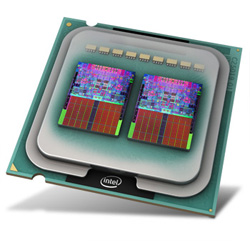Parallel
Systems - Practica
Until 2016, the practicum
was part of the course. Now, we discuss some of the exercises
during the theory.
- edu.cmu.tetrad.data.LongColumn
to average out results of multiple experiments.
- be.ac.vub.ir.data.Chart
to show data.
- be.ac.vub.ir.data.FrequencyTable
to show a frequency table
 Room 4k228 computer
specifications
Room 4k228 computer
specifications
 |
- CPU Speed: 2.66
GHz
- 64 bit processor
- Level 2 cache: 2 x
4 MB (each L2 cache is shared between 2
cores)
- Level 1 instruction cache: 4 x 32 KB
- Level 1 data cache: 4 x 32 KB
- Architecture
- RAM: 4 GB
- Graphics Card: NVIDIA
GeForce 9400GT
- has 16 'cores' and supports CUDA for general purpose
computing...
|
 |
 Exercises
Exercises
Tips:
- Use -Xmx256M
as VM argument if more memory is needed (set in Eclipse for
sequential or multithreaded algorithms or after the mpjrun.bat
for message-passing algorithms)
- Call the garbage collector (between 2 experiments) with Runtime.getRuntime().gc();
Memory
Access Overhead (NOT THIS YEAR)
|
1.
Test the cache miss penalty with the array traveling program ArrayWalking. Solution
- Can you estimate the cost of a Level 1 and Level 2 cache
miss?
- Can you estimate the relative memory latency Lambda (PPP
page 66) for the different memory levels?
2.
Test if latency hiding can be obtained with file reading from
system and from url in a separate thread (FileReading.java).
Solution
- By running on multiple cores, by running on one core (set
affinity of eclipse process to 1 core in Windows' Task
Manager).
3. Implement a multithreaded fibonacci
algorithm (Fibonacci.java).
Solution!
- Base the calculations on the following recursive definition.
This is of course not the most intelligent solution, actually
terribly dumb. Let's assume
that it is a good way of calculating fibonacci. Since
it generates a lot of computations, it is good for obtaining
speedup when run in parallel!
- Fibonacci (n) = Fibonacci (n-1) + Fibonacci (n-1) if
n > 2
- Fibonacci (n) = 1 if n = 1 or n = 2
- Fibonacci (n) = 0 if n < 1
- There are several ways to decompose the problem. Try to find
a solution for which you can parameterize the number of
threads.
- Study the performance in function of the number of
threads.
- Try to get an ideal speedup (= number of cores).
- If this ideal is not met, try to find an explanation!
- Advanced questions:
Is it a load-balanced solution? Count the number of threads.
Count the number of work of each thread or time the
computation time of each thread.
4. Implement a
multithreaded matrix multiplication. Solution
- Try to make a solution in which you can set the number of
threads.
- What speedup do you obtain?
- What is the maximal number ot threads?
- How does the speedup evolves with increasing number of
threads? And with increasing matrix size?
- Try to estimate the thread overhead by testing solutions
with different number of threads.
5. Test the the performance of various Count3s
implementations.
Solution
- The given first solution is wrong. Why?
- What happens if you limit the cores to 1 on which your
program may run?
- Explore the following solutions (their correctness and their
performance):
- This is the given solution without any form of
synchronization.
- Try to protect the counter variable with a boolean
preventing multiple access to the counter. Does this work?
- Use yield()
to give hints to the OS to do a context switch.
- Do the race conditions disappear by making the count
variable volatile?
- Use synchronized to
protect the critical section. There are 2 ways to do this.
- Use a private counter to increase the performance.
- Lin & Snyder (page 37) claim that padding increases
performance (overcoming false sharing). Test the claim?
- Test whether false sharing happens when a (global) array
is used in which each thread uses one element as private
counter (idea of student Thierry Renaux, 2011). Try if
padding helps to overcome false sharing.
- For an example of how padding might improve
performance, examine the following code: False Sharing
(idea of student Cristoph de Troyer, 2014)
- Visualization
of speedup on 8 cores
- Solve Count3s by making use of an atomic counter (see
java.util.concurrent.atomic package, Java API Doc).
- Correct solution 2 by making use of AtomicBoolean (idea
of student Sven Claeys, 2009).
- Alternative for 5: let the main thread globalize the
private counters (idea of student Robrecht Dewaele, 2010).
- Can you invent another
solution?
6. Check Invariance-breaking with volatile (Slide 55). Solution
- In the threads, do a
lot of updates of the upper and lower values to generate race
conditions. Check the invariant each time, so that you see
when it is broken.
- Don't put extra print statements in the threads. They will
considerably slow down the threads and lower the chance of a
race condition.
- Why don't you get a thread-safe solution with volatile?
Which solution gives a correct program?
- Test it with at least 10.000.000 iterations.
- Can something go wrong with CheckInvariant?
7. Break the
'monitorness' of an object so that two synchronized methods (here:
f1 and f2) can be accessed simultaneously. Solution
- Verify first the monitorness of the ObjectAsMonitor by
comparing synchronized with unsynchronized methods.
8. Implement a Barrier (PPP page 193) and call the
barrier in the previous exercise after each iteration. Solution
- Replaces the join in the previous exercise with a barrier
call at the end of the thread and in the main.
- Optional: Implement
a split-phase barrier (PPP page 193) and uses it in the
previous example after each iteration. The condition is that a
thread can only start the next iteration if everybody has
finished f1(). f2() is therefore the useful work that can be
done while waiting.
- As correctly pointed out by Christophe De Troyer, the
solution is a bit more complex, especially if you are going to
reuse the barrier object iteratively:
- We should take into account the possibility if spurious
wakeups
- If the same barrier is used repetitively you should ensure
that all threads have left the barrier before early threads
already start entering.
Indeed, the java
NotifyAll does not guarantee that the ownership is
passed to the awakened threads: “after activation due to a
notify, the inactive thread start wanting to run in the
synchronized block again, but is treated equaly with all
other threads that wants it”
Christophe
De Troyer's November 2014 solution takes care of these
issues!
9. Implement a
multithreaded solution for the following matrix update algorithm.
See figure and Wavefront.java.
Solution
- The matrix is updated row-by-row from left to right. Each
element is updated by adding the latest value of
the upper element and by subtracting the left element.
- Implement a highly-parallel solution which is correct. Check
the correctness of the parallel result. The performance is not
the major goal here.
- The parallelism lies in the wavefront, as indicated on the figure.
- Hint: use one
thread per row.
- How could you make it faster?
- Optional: do the
update multiple times.
10. Implement a multithreaded solution for this
iterative algorithm. Start from BarrierWithReduction.java.
Solution
- The given program is a simple version of an iterative
algorithm in which local computations have to be followed by a
global calculation (reduction), as shown by this
figure. This structure appears in several parallel
algorithms, such as a parallel Dijkstra algorithm. The simple
program is given so that you can concentrate on the
synchronization, which is not trivial.
- Create a thread that calculates the value of each array
element. Create a separate 'master' thread that does the
reduction.
- Make sure it is 100
% thread-safe and all threads finish.
11. An application of the double
condition problem (cf PPP p. 173) with a deadlock: ApplesOrangesWithDeadlock.java.
Make it deadlock-free.
- There are apple producer threads and there are orange
producers. The first consume 1 apple and 1 orange to produce 2
apples, the second consume 1 apple and 1 orange to produce 2
oranges.
- Note that the code is written in Pthread-style as you would
do in C. It uses Locks and Condition Variables.
- Note that if you remove the sleep() before the consume the
application doesn't seem to deadlock.
12. Computing the surface of the
Mandelbrot set Mandelbrot.txt.
- You are given a template to compute the surface of a
Mandelbrot set. Implement a multithreaded version of this
code.
- The task here is to get as good a speedup as possible. Think
how to decompose the problem to achieve this
OPTIONAL: Implement an efficient and
deadlock-free solution for the Dining Philosophers problem.
- Efficiency is in terms of the time the philosophers are
hungry. You should try to minimize starvation time.
 Exercises code
13-18 - FastMPJ
Download - MPJExpress
Quick Start (Installation
and user guide,
Environment variables for FastMPJ , etc) -
MPJ
Express API doc - Quick
reference 1 and page 2
Exercises code
13-18 - FastMPJ
Download - MPJExpress
Quick Start (Installation
and user guide,
Environment variables for FastMPJ , etc) -
MPJ
Express API doc - Quick
reference 1 and page 2
13. Implement
a message-passing
CountingPrimes algorithm (start from
Counting Primes
and
). MPITest Solution
Solution with Collective Communication (by Sarah ElShal)
- What is the efficiency of the parallel solution? Does it
maximally exploits the parallel processing power? Can you
optimize the solution?
- Study the speedup of CountingPrimes in function of array
size and number of processes.
- Compare it with the message-passing Counting3s solution.
Which is more efficient?
- Study the message-passing Counting3s solution. Does it
give a good speedup? Why (not)?
- If not done in your first solution, try to use MPI's collective communication
operations in a second version.
14. Study the default send & receive protocol
(DefaultProtocol.java) which can result in a deadlock situation.
- MPJ
Readme (check protocol switch limit)
- Implement at least 3 different solution that avoids the
possibility of a deadlock.
15. Implement a message-passing version of the
BarrierWithReduction algorithm
(exercise 10). Solution
16.
Implement a message-passing version of the matrix update algorithm using the wavefront approach (exercise
9). Complete solution
17. Java
provides automatic object serialization.
- Sun
Documentation and examples
- Object2ByteArray shows
in what bytestream an object is transformed.
- Object2File shows
object
writing and reading to file.
- Try changing serialVersionUID.
- ObjectCommunication
shows how the bytestream can be send through MPI.
- Optional: The previous solution can be optimized:
- By creating your own OutputStream. ByteArrayOutputStream.toByteArray()
gives a copy of the byte array.
- The byte array of Object serialization can happen more
dense by implementing the Externalizable interface.
- Now that we have seen how to serialize and communicate
objects, it is clear that sending objects is possible in MPI.
18. NOT THIS YEAR.
Test the communication performance of point-to-point
communication.
- Measure the communication time/per integer for increasing
message sizes, SendModes.java
gives you the opportunity to do so.
- This code lets you test different send modes.
- Run with the -H options to see the program arguments.
- How much computations do I
have to do to make it worth to do it remotely? The
computation time should exceed the time to send the data.
Measure the boundary value between speedup and slowdown.
- Measure a message-passing equivalent for Lambda (the
relative memory latency).
- Also measure the performance characteristics for processes
running on the same processor.
go here
| Performance
Analysis (NOT THIS YEAR) |
23. Design and do a performance analysis of a parallel
pipeline algorithm.
- This was an exam question in january 2008.
- Design (implementing is not necessary) a generic parallel
solution for algorithms that can be pipelined. The problem
class is defined as follows:
- We have nd data
packages that have to be processed by a np process objects.
- Each process object has to process the data packages in
the right order, because its state is changed after the
processing of each data package.
- Each data package can also be changed by the process.
Therefore, it should also be processed by all process
objects in the right order.
- A correct sequential algorithm looks like this:
Data[] data
= getData();
Process[] processes = createProcesses();
for(Data d: data)
for(Process p: processes)
p.process(d);
- Do a performance analysis (see theory)
- Draw an execution profile of the parallel solution to
explain it.
- Define the classes and major methods. You do not have to
implement them, just sketch the solution.
- What are the overheads and possible performance
bottlenecks. How can they be countered?
- Actually there are 2 possible parallel solutions. For
which solution should one opt? Depends on what?
Generic
Parallel Solutions (NOT THIS YEAR)
|
19. Design a two-fold generic parallel solution for data-parallel farming
algorithms (assume independent data parallelism).
Interface
Definition Ruben's implementation
- data parallelism: the same thing (called the task) has to be
performed on different data elements.
- Independent means that the tasks do not need information
from each other, they can run completely independently
- Examples:
- checks whether each element of an array is a prime. Input:
int array; output: boolean array
- checks whether each element of an array is divisible by y
(with y a parameter of the program). Input: int array;
output: boolean array
- Combine multithreading and message-passing.
- Implement a simple solution based on a general Task class.
- For testing: each task counts the number of primes for a
given interval. Generate a number of tasks with random
intervals.
- Start with the CountingPrimes example code (see earlier
exercises).
- List the functionalities that would improve the performance
of your solution.
20. Transform the CountingPrimes program into a
generic parallel solution that can be applied for a larger class
of problems, without increasing the complexity of the solution.
- See notes of lesson on Good
Programming Practice.
- Extract the parameters and methods that should be provided
by the user. Define the abstract class with which the generic
solution will work.
- What will the user have to provide in the case of counting
the prime numbers?
- Change the CountingPrimes program so that it works with the
abstract class.
- Clearly define the problem class for which your solution
applies!
- There are several possible
solutions. What are the differences between the solutions?
21.
Implement a message-passing generic framework for reduction operations.
22. Design a two-fold generic parallel solution for genetic algorithms.
- Define the classes and major methods. You do not have to
implement them, just sketch the solution.
23. Design a two-fold generic parallel solution for algorithms that can be pipelined.
- The problem class is defined as follows:
- We have nd data
packages that have to be processed by a np process objects.
- Each process object has to process the data packages in
the right order, because its state is changed after the
processing of each data package.
- Each data package can also be changed by the process.
Therefore, it should also be processed by all process
objects in the right order.
- A correct sequential algorithm looks like this:
Data[] data
= getData();
Process[] processes = createProcesses();
for(Data d: data)
for(Process p: processes)
p.process(d);
- Draw an execution profile of the parallel solution to
explain it.
- Define the classes and major methods. You do not have to
implement them, just sketch the solution.
- What are the overheads and possible performance bottlenecks.
How can they be countered?
- Actually there are 2 possible parallel solutions. For
which solution should one opt? Depends on what?
- This was an exam question in january 2008.
- Back to the
top -
 Documentation: parallel.vub.ac.be
Documentation: parallel.vub.ac.be Documentation: parallel.vub.ac.be
Documentation: parallel.vub.ac.be Utility classes (check
main method for usage)
Utility classes (check
main method for usage)  v1.1 jar-file
v1.1 jar-file
 v1 jar-file
v1 jar-file  code
code
 our default
libraries (install at least mpj.jar)
our default
libraries (install at least mpj.jar) Room 4k228 computer
specifications
Room 4k228 computer
specifications

 Exercises
Exercises Exercises code
13-18 - FastMPJ
Download - MPJExpress
Quick Start (Installation
and user guide,
Environment variables for FastMPJ , etc) -
MPJ
Express API doc - Quick
reference 1 and page 2
Exercises code
13-18 - FastMPJ
Download - MPJExpress
Quick Start (Installation
and user guide,
Environment variables for FastMPJ , etc) -
MPJ
Express API doc - Quick
reference 1 and page 2